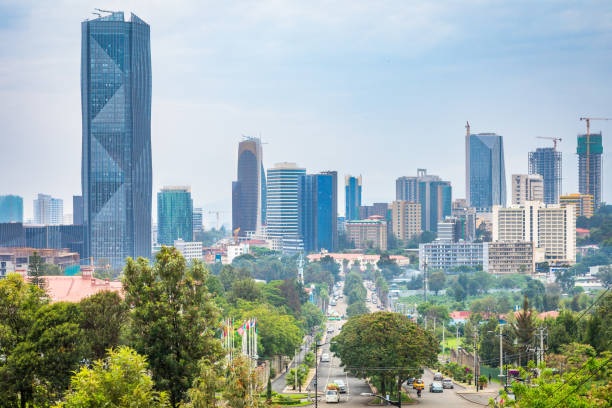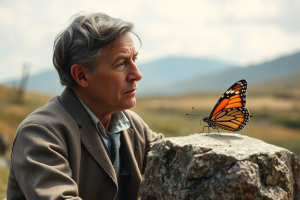
A city can be conceived as both a work of art and architecture. A city is not only a conglomeration of buildings and roads. It is also the expression of architectural harmony. Buildings without colors are like skeletons; they have no life, no beauty no attraction to the eye. They rather look like graveyards. The same can be said about a city that has too many colors on display but the colors exhibit no harmony. This was largely the condition of many buildings in Addis until recently, that is to say before the onset of the current renovation or face lifting campaign.
Cities are sometimes like human beings. They are born, grow and age if not die. There are many cities around the world that have died of old age or natural and historical accidents like wars or earthquakes. Entire cities are buried following violent earthquakes that covered the houses and roads with a thick carpet of hot magma and then when the magma cooled down, it is reduced into a kind of natural cement that buries everything underground and reduced them to ashes. The ancient city of Carthage may be sited as an example. Ancient cities that disappeared in such a way are now remembered by their names alone.
One aspect of the criticism often expressed by architects in Addis was the fact that the city was built haphazardly, without any aesthetic consideration. It was as if the building were thrown from the sky and landed on earth disorderly. Or like pieces of dice are thrown on the table and display no pattern, no harmony or no color.
Most cities are built spontaneously or accidentally, long before architecture became a science and an art and master plans were not invented. Addis Ababa is a good example/ it started out as a town in a big forest. The green of eucalyptus trees was the dominant color and motif. There were primitive huts were dotting the landscape and rivers of clean waters were meandering through the “Amazonian” landscape. That was the green and of course the clean period of Addis as a town and then as a city. Indeed, cities are like artists, they have their periods or timeline or time limit, if you like.
Picasso had his blue, yellow or red period and finally the cubist period. Then came his cubist period as the dominant motif. The same can be said about Afewerk Tekle who had what we may call his traditional and modernist periods that displayed abstract or sometimes surrealist motifs side by side with traditional themes. Eskunder Bogossian started and ended with abstract art while Gebrekristos Desta mixed poetry with painting and can be categorized as a modernist artist.
Addis Ababa too had its colorless and colorful periods.
A city is also a work of art in another sense. It’s objective, although understated or often overlooked, is the creation of beauty, or aesthetics. The architectural facelift currently ongoing around the main city centers and boulevards of Addis can also be seen as an effort to beautify the city by discarding the old. It may also be seen as an architectural/artistic facelift. It can also be called the beautification of the capital with colors alone, without changing the architecture. This is a faster and more economical way of adding aesthetics to the city.
Addis Ababa has so far three periods in its more than a century of its evolution, if we are allowed to conceive it as a work of art. The green or the eucalyptus period. The chaotic or disorderly period when buildings and roads were constructed without a clear plan but depending on the whims of the municipal authorities.
The second stage or period in the life of Addis was what we may call the chaotic or disorderly period when buildings and roads were constructed without a pattern, a plan or with harmony. Urban development was haphazard and without a direction. Addis Ababa was considered a big destination for people from the rural areas where opportunities were limited and modernization was setting foot in the New Flower. The third period is underway now and we can call this the return back to the green period with a good doze of modernization going with it. The first green period of Addis as a town in the middle of a forest, was natural.
The present stage of return to greening is man-made or artificial. It is technological as well as state of the art. The greening projects are proceeding with the redesigning and reconstruction of the Ethiopian capital. The projects were not always smooth or free from demolishing and rebuilding process that has claimed so many livelihoods. This may be seen as the cost of reconstruction. No doubt that the process has taken a toll and many lives and livelihoods s have been affected.
Rising temperature in the Ethiopian capital these days is causing great concern among residents as well as environmentalists who are nostalgic of the good old whether of Addis that was neither hot nor cold but something in the between. Climate change seems to be catching on the city. Extreme temperatures are not rare these days. The cold of the night is felt deep into your bones. And dawn in Addis welcomes you with its touch of hazy shivering before early morning caresses you with its warm hands of sunshine.
When Addis was funded more than a century ago by the first modernizing emperor it was something like a sparsely inhabited town in the middle of a vast forest area extending from mount Entoto in the north extending down to mount Zikwala in Bishftu down to the south. Addis at that time bore all the features of a primal town populated by the first inhabitant who came in search of better opportunities. Addis must also be one of the fastest growing cities in Africa.
In a little more than a century it has evolved into a sprawling and modern capital expanding both horizontally and vertically. Its forests are now decimated, its rivers polluted, its air difficult to breathe. Its temperature is also compromised. Nowadays, Addis in summer feels and looks like a city in the middle of a desert. It is now becoming famous or infamous it depends on how you look at it, for its almost unbearable heat in the dry season.
The negative effects of climate change has never been more evident in Addis where the passion for tree planting was done on a gigantic scale and then crushed down while it is now at its lowest, if not totally overlooked. The tree planting obsession had even caught international attention and was considered a national pride. That was the biggest tree planting initiative since Emperor Menelik brought the seedlings of the eucalyptus trees from Australia and planted them on the Entoto hills and subsequently spread throughout the country.
Addis Ababa whether is now changing from temperate to hot not only because of climate change. The construction of skyscrapers with glass walls and window has also aggravated the emission or reflection of heat to the atmosphere. In former times building were built with heat absorbing materials like cement which was recently replaced with aluminum and glass as a result of the technological advances in building construction. This has contributed to the high level of heat in Addis which is assuming increasingly cosmopolitan features. Since the problem of temperature is not included in the designing and engineering of the buildings, hot seasons in Addis are becoming hotter than usual. And when the architects and designers woke up to the reality it may be too late to make corrections.
The new headquarters of the Commercial Bank of Ethiopia (CBE) can serve as a case in point as far as this problem is concerned. This is not only the highest building in the capital but also entirely covered with aluminum and glass. Moreover, the site on which it is built is part of the volcanically active part of the city around Filowa or the public bath outlet whose underground water is naturally heated by the effects of the active or dormant volcano beneath. It is not clear whether proper risk assessment was done on the site prior to the construction of this ultra-modern structure. However recent events in the area might indicate towards the probability volcanic activities in that area.
Climate change or seismic activities are natural phenomenon that call for different solutions or approaches. The recent construction of parks and recreational facilities and the forestation of vacant spaces in Addis is believed to have a positive impact in reducing excessive heat during the day although these projects were meant not as preventive but as beautifying measures. The present rise in temperature should therefore create awareness among the municipal authorities as the need for the expansion of forested areas in the city.
The pace of public park development, tree planting as well as the general beautification of Addis Ababa is proceeding at a breakneck pace although it may not keep pace with the rise in daily temperature in some parts of the city. It is therefore incumbent on the pertinent city developers to give due attention to the public health hazards long-term exposure to excessive heat might create.
Addis Ababa might be in its third period of evolution from a sparsely built town in the forest to a sprawling African metropolis. The next phase of its growth should not be a transition to a vast forest of glass and aluminum buildings but a partial return to the primeval forest of its older times. The objective should rather be one of turning Addis into the greenest city in Africa.
BY MULUGETA GUDETA
THE ETHIOPIAN HERALD WEDNESDAY 26 FEBRUARY 2025




